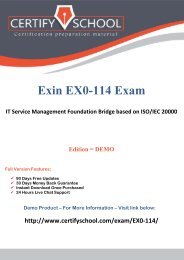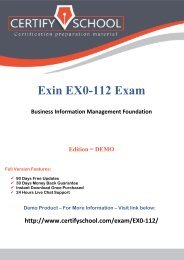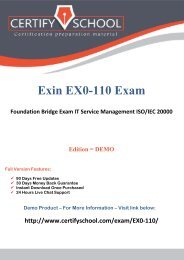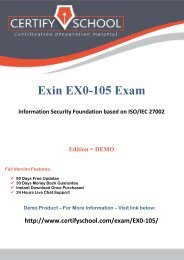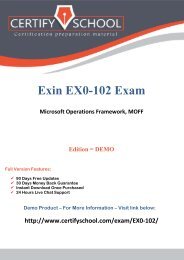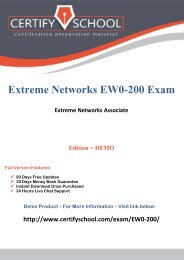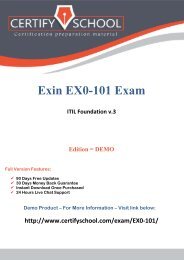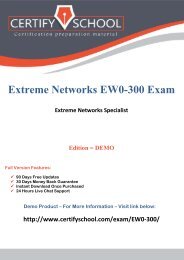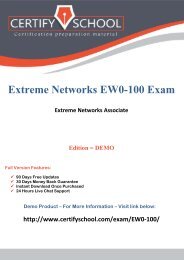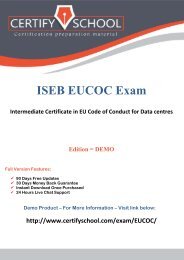EC0-350 Exam
For more Full product Details:www.CertifySchool.com Our workable study material for exam meets the exact and accurate exam questions and answers. So that’s why CertifySchool is popular in the field of IT Certification Exams material providers.Please visit site: www.certifyschool.com/
For more Full product Details:www.CertifySchool.com
Our workable study material for exam meets the exact and accurate exam questions and answers. So that’s why CertifySchool is popular in the field of IT Certification Exams material providers.Please visit site: www.certifyschool.com/
Create successful ePaper yourself
Turn your PDF publications into a flip-book with our unique Google optimized e-Paper software.
www.CertifySchool.com Certification Preparation Material (PDF)<br />
Eccouncil <strong>EC0</strong>-<strong>350</strong> <strong>Exam</strong><br />
Ethical Hacking and Countermeasures<br />
Edition = DEMO<br />
Full Version Features:<br />
90 Days Free Updates<br />
30 Days Money Back Guarantee<br />
Instant Download Once Purchased<br />
24 Hours Live Chat Support<br />
Demo Product – For More Information – Visit link below:<br />
http://www.certifyschool.com/exam/<strong>EC0</strong>-<strong>350</strong>/<br />
http://www.certifyschool.com/exam/<strong>EC0</strong>-<strong>350</strong>/<br />
Page | 1
www.CertifySchool.com Certification Preparation Material (PDF)<br />
Question: 1<br />
Which of the following countermeasure can specifically protect against both the MAC Flood and MAC Spoofing<br />
attacks<br />
A. Configure Port Security on the switch<br />
B. Configure Port Recon on the switch<br />
C. Configure Switch Mapping<br />
D. Configure Multiple Recognition on the switch<br />
Question: 2<br />
Answer: A<br />
Jimmy, an attacker, knows that he can take advantage of poorly designed input validation routines to create or alter<br />
SQL commands to gain access to private data or execute commands in the database. What technique does Jimmy<br />
use to compromise a database<br />
A. Jimmy can submit user input that executes an operating system command to compromise a target system<br />
B. Jimmy can gain control of system to flood the target system with requests, preventing legitimate users from<br />
gaining access<br />
C. Jimmy can utilize an incorrect configuration that leads to access with higher-than expected privilege of the<br />
database<br />
D. Jimmy can utilize this particular database threat that is an SQL injection technique to penetrate a target system<br />
Question: 3<br />
Answer: D<br />
This IDS defeating technique works by splitting a datagram (or packet) into multiple fragments and the IDS will not<br />
spot the true nature of the fully assembled datagram. The datagram is not reassembled until it reaches its final<br />
destination. It would be a processor-intensive task for IDS to reassemble all fragments itself, and on a busy system<br />
the packet will slip through the IDS onto the network. What is this technique called<br />
A. IP Routing or Packet Dropping<br />
B. IDS Spoofing or Session Assembly<br />
C. IP Fragmentation or Session Splicing<br />
D. IP Splicing or Packet Reassembly<br />
Question: 4<br />
Answer: C<br />
If a competitor wants to cause damage to your organization, steal critical secrets, or put you out of business, they<br />
just have to find a job opening, prepare someone to pass the interview, have that person hired, and they will be in<br />
the organization.<br />
http://www.certifyschool.com/exam/<strong>EC0</strong>-<strong>350</strong>/<br />
Page | 2
www.CertifySchool.com Certification Preparation Material (PDF)<br />
How would you prevent such type of attacks<br />
A. It is impossible to block these attacks<br />
B. Hire the people through third-party job agencies who will vet them for you<br />
C. Conduct thorough background checks before you engage them<br />
D. Investigate their social networking profiles<br />
Question: 5<br />
Answer: C<br />
This type of Port Scanning technique splits TCP header into several packets so that the packet filters are not able to<br />
detect what the packets intends to do.<br />
A. UDP Scanning<br />
B. IP Fragment Scanning<br />
C. Inverse TCP flag scanning<br />
D. ACK flag scanning<br />
Question: 6<br />
Answer: B<br />
Joel and her team have been going through tons of garbage, recycled paper, and other rubbish in order to find some<br />
information about the target they are attempting to penetrate. How would you call this type of activity<br />
A. Dumpster Diving<br />
B. Scanning<br />
http://www.certifyschool.com/exam/<strong>EC0</strong>-<strong>350</strong>/<br />
Page | 3
www.CertifySchool.com Certification Preparation Material (PDF)<br />
C. CI Gathering<br />
D. Garbage Scooping<br />
Question: 7<br />
Answer: A<br />
Anonymizer sites access the Internet on your behalf, protecting your personal information from disclosure. An<br />
anonymizer protects all of your computer's identifying information while it surfs for you, enabling you to remain at<br />
least one step removed from the sites you visit. You can visit Web sites without allowing anyone to gather<br />
information on sites visited by you. Services that provide anonymity disable pop-up windows and cookies, and<br />
conceal visitor's IP address. These services typically use a proxy server to process each HTTP request. When the user<br />
requests a Web page by clicking a hyperlink or typing a URL into their browser, the service retrieves and displays the<br />
information using its own server. The remote server (where the requested Web page resides) receives information<br />
on the anonymous Web surfing service in place of your information. In which situations would you want to use<br />
anonymizer (Select 3 answers)<br />
A. Increase your Web browsing bandwidth speed by using Anonymizer<br />
B. To protect your privacy and Identity on the Internet<br />
C. To bypass blocking applications that would prevent access to Web sites or parts of sites that you want to visit.<br />
D. Post negative entries in blogs without revealing your IP identity<br />
Question: 8<br />
Answer: B, C, D<br />
What type of attack is shown in the following diagram<br />
A. Man-in-the-Middle (MiTM) Attack<br />
B. Session Hijacking Attack<br />
C. SSL Spoofing Attack<br />
D. Identity Stealing Attack<br />
Answer: A<br />
http://www.certifyschool.com/exam/<strong>EC0</strong>-<strong>350</strong>/<br />
Page | 4
www.CertifySchool.com Certification Preparation Material (PDF)<br />
Question: 9<br />
Jack Hacker wants to break into Brown Co.'s computers and obtain their secret double fudge cookie recipe. Jack calls<br />
Jane, an accountant at Brown Co., pretending to be an administrator from Brown Co. Jack tells Jane that there has<br />
been a problem with some accounts and asks her to verify her password with him ''just to double check our<br />
records.'' Jane does not suspect anything amiss, and parts with her password. Jack can now access Brown Co.'s<br />
computers with a valid user name and password, to steal the cookie recipe. What kind of attack is being illustrated<br />
here<br />
A. Reverse Psychology<br />
B. Reverse Engineering<br />
C. Social Engineering<br />
D. Spoofing Identity<br />
E. Faking Identity<br />
Question: 10<br />
Answer: C<br />
How do you defend against ARP Spoofing Select three.<br />
A. Use ARPWALL system and block ARP spoofing attacks<br />
B. Tune IDS Sensors to look for large amount of ARP traffic on local subnets<br />
C. Use private VLANS<br />
D. Place static ARP entries on servers, workstation and routers<br />
Answer: A, C, D<br />
Explanation:<br />
ARPwall is used in protecting against ARP spoofing.<br />
Incorrect answer:<br />
IDS option may works fine in case of monitoring the traffic from outside the network but not from internal hosts.<br />
Question: 11<br />
TCP SYN Flood attack uses the three-way handshake mechanism.<br />
1. An attacker at system A sends a SYN packet to victim at system B<br />
2. System B sends a SYN/ACK packet to victim A<br />
3. As a normal three-way handshake mechanism system A should send an ACK packet to system B, however, system<br />
A does not send an ACK packet to system B. In this case client B is waiting for an ACK packet from client A<br />
This status of client B is called _________________<br />
A. "half-closed"<br />
B. "half open"<br />
C. "full-open"<br />
D. "xmas-open"<br />
Answer: B<br />
http://www.certifyschool.com/exam/<strong>EC0</strong>-<strong>350</strong>/<br />
Page | 5
www.CertifySchool.com Certification Preparation Material (PDF)<br />
Question: 12<br />
Lori is a Certified Ethical Hacker as well as a Certified Hacking Forensics Investigator working as an IT security<br />
consultant. Lori has been hired on by Kiley Innovators, a large marketing firm that recently underwent a string of<br />
thefts and corporate espionage incidents. Lori is told that a rival marketing company came out with an exact<br />
duplicate product right before Kiley Innovators was about to release it. The executive team believes that an<br />
employee is leaking information to the rival company. Lori questions all employees, reviews server logs, and firewall<br />
logs; after which she finds nothing. Lori is then given permission to search through the corporate email system. She<br />
searches by email being sent to and sent from the rival marketing company. She finds one employee that appears to<br />
be sending very large email to this other marketing company, even though they should have no reason to be<br />
communicating with them. Lori tracks down the actual emails sent and upon opening them, only finds picture files<br />
attached to them. These files seem perfectly harmless, usually containing some kind of joke. Lori decides to use<br />
some special software to further examine the pictures and finds that each one had hidden text that was stored in<br />
each picture. What technique was used by the Kiley Innovators employee to send information to the rival marketing<br />
company<br />
A. The Kiley Innovators employee used cryptography to hide the information in the emails sent<br />
B. The method used by the employee to hide the information was logical watermarking<br />
C. The employee used steganography to hide information in the picture attachments<br />
D. By using the pictures to hide information, the employee utilized picture fuzzing<br />
Question: 13<br />
Answer: C<br />
You run nmap port Scan on 10.0.0.5 and attempt to gain banner/server information from services running on ports<br />
21, 110 and 123. Here is the output of your scan results:<br />
Which of the following nmap command did you run<br />
A. nmap -A -sV -p21, 110, 123 10.0.0.5<br />
B. nmap -F -sV -p21, 110, 123 10.0.0.5<br />
C. nmap -O -sV -p21, 110, 123 10.0.0.5<br />
D. nmap -T -sV -p21, 110, 123 10.0.0.5<br />
Answer: C<br />
http://www.certifyschool.com/exam/<strong>EC0</strong>-<strong>350</strong>/<br />
Page | 6
www.CertifySchool.com Certification Preparation Material (PDF)<br />
Question: 14<br />
How do you defend against Privilege Escalation<br />
A. Use encryption to protect sensitive data<br />
B. Restrict the interactive logon privileges<br />
C. Run services as unprivileged accounts<br />
D. Allow security settings of IE to zero or Low<br />
E. Run users and applications on the least privileges<br />
Question: 15<br />
Answer: A, B, C, E<br />
What does ICMP (type 11, code 0) denote<br />
A. Source Quench<br />
B. Destination Unreachable<br />
C. Time Exceeded<br />
D. Unknown Type<br />
Question: 16<br />
Answer: C<br />
You are the security administrator of Jaco Banking Systems located in Boston. You are setting up e-banking website<br />
(http://www.ejacobank.com) authentication system. Instead of issuing banking customer with a single password,<br />
you give them a printed list of 100 unique passwords. Each time the customer needs to log into the e-banking system<br />
website, the customer enters the next password on the list. If someone sees them type the password using shoulder<br />
surfing, MiTM or keyloggers, then no damage is done because the password will not be accepted a second time.<br />
Once the list of 100 passwords is almost finished, the system automatically sends out a new password list by<br />
encrypted e-mail to the customer. You are confident that this security implementation will protect the customer<br />
from password abuse. Two months later, a group of hackers called "HackJihad" found a way to access the one-time<br />
password list issued to customers of Jaco Banking Systems. The hackers set up a fake website (http://www.ejacobank.com)<br />
and used phishing attacks to direct ignorant customers to it. The fake website asked users for their e-<br />
banking username and password, and the next unused entry from their one-time password sheet. The hackers<br />
collected 200 customer's username/passwords this way. They transferred money from the customer's bank account<br />
to various offshore accounts. Your decision of password policy implementation has cost the bank with USD 925, 000<br />
to hackers. You immediately shut down the e-banking website while figuring out the next best security solution.<br />
What effective security solution will you recommend in this case<br />
A. Implement Biometrics based password authentication system. Record the customers face image to the<br />
authentication database<br />
B. Configure your firewall to block logon attempts of more than three wrong tries<br />
C. Enable a complex password policy of 20 characters and ask the user to change the password immediately after<br />
they logon and do not store password histories<br />
D. Implement RSA SecureID based authentication system<br />
Answer: D<br />
http://www.certifyschool.com/exam/<strong>EC0</strong>-<strong>350</strong>/<br />
Page | 7
www.CertifySchool.com Certification Preparation Material (PDF)<br />
Question: 17<br />
More sophisticated IDSs look for common shellcode signatures. But even these systems can be bypassed, by using<br />
polymorphic shellcode. This is a technique common among virus writers it basically hides the true nature of the<br />
shellcode in different disguises. How does a polymorphic shellcode work<br />
A. They encrypt the shellcode by XORing values over the shellcode, using loader code to decrypt the shellcode, and<br />
then executing the decrypted shellcode<br />
B. They convert the shellcode into Unicode, using loader to convert back to machine code then executing them<br />
C. They reverse the working instructions into opposite order by masking the IDS signatures<br />
D. They compress shellcode into normal instructions, uncompress the shellcode using loader code and then<br />
executing the shellcode<br />
Question: 18<br />
Answer: A<br />
SYN Flood is a DOS attack in which an attacker deliberately violates the three-way handshake and opens a large<br />
number of half-open TCP connections. The signature of attack for SYN Flood contains:<br />
A. The source and destination address having the same value<br />
B. A large number of SYN packets appearing on a network without the corresponding reply packets<br />
C. The source and destination port numbers having the same value<br />
D. A large number of SYN packets appearing on a network with the corresponding reply packets<br />
Question: 19<br />
Answer: B<br />
Which of the following type of scanning utilizes automated process of proactively identifying vulnerabilities of the<br />
computing systems present on a network<br />
A. Port Scanning<br />
B. Single Scanning<br />
C. External Scanning<br />
D. Vulnerability Scanning<br />
Question: 20<br />
Answer: D<br />
The following script shows a simple SQL injection. The script builds an SQL query by concatenating hard-coded strings<br />
together with a string entered by the user:<br />
http://www.certifyschool.com/exam/<strong>EC0</strong>-<strong>350</strong>/<br />
Page | 8
www.CertifySchool.com Certification Preparation Material (PDF)<br />
The user is prompted to enter the name of a city on a Web form. If she enters Chicago, the query assembled by the<br />
script looks similar to the following:<br />
SELECT * FROM OrdersTable WHERE ShipCity = 'Chicago'<br />
How will you delete the OrdersTable from the database using SQL Injection<br />
A. Chicago'; drop table OrdersTable --<br />
B. Delete table'blah'; OrdersTable --<br />
C. EXEC; SELECT * OrdersTable > DROP --<br />
D. cmdshell'; 'del c:\sql\mydb\OrdersTable' //<br />
Question: 21<br />
Answer: A<br />
What are the limitations of Vulnerability scanners (Select 2 answers)<br />
A. There are often better at detecting well-known vulnerabilities than more esoteric ones<br />
B. The scanning speed of their scanners are extremely high<br />
C. It is impossible for any, one scanning product to incorporate all known vulnerabilities in a timely manner<br />
D. The more vulnerabilities detected, the more tests required<br />
E. They are highly expensive and require per host scan license<br />
Question: 22<br />
Answer: A, C<br />
Stephanie works as senior security analyst for a manufacturing company in Detroit. Stephanie manages network<br />
security throughout the organization. Her colleague Jason told her in confidence that he was able to see confidential<br />
corporate information posted on the external website http://www.jeansclothesman.com. He tries random URLs on<br />
the company's website and finds confidential information leaked over the web. Jason says this happened about a<br />
month ago. Stephanie visits the said URLs, but she finds nothing. She is very concerned about this, since someone<br />
should be held accountable if there was sensitive information posted on the website. Where can Stephanie go to see<br />
past versions and pages of a website<br />
A. She should go to the web page Samspade.org to see web pages that might no longer be on the website<br />
B. If Stephanie navigates to Search.com; she will see old versions of the company website<br />
C. Stephanie can go to Archive.org to see past versions of the company website<br />
D. AddressPast.com would have any web pages that are no longer hosted on the company's website<br />
Question: 23<br />
Answer: C<br />
Dan is conducting penetration testing and has found a vulnerability in a Web Application which gave him the<br />
sessionID token via a cross site scripting vulnerability. Dan wants to replay this token. However, the session ID<br />
manager (on the server) checks the originating IP address as well. Dan decides to spoof his IP address in order to<br />
replay the sessionID. Why do you think Dan might not be able to get an interactive session<br />
A. Dan cannot spoof his IP address over TCP network<br />
B. The scenario is incorrect as Dan can spoof his IP and get responses<br />
http://www.certifyschool.com/exam/<strong>EC0</strong>-<strong>350</strong>/<br />
Page | 9
www.CertifySchool.com Certification Preparation Material (PDF)<br />
C. The server will send replies back to the spoofed IP address<br />
D. Dan can establish an interactive session only if he uses a NAT<br />
Question: 24<br />
Answer: C<br />
Jason works in the sales and marketing department for a very large advertising agency located in Atlanta. Jason is<br />
working on a very important marketing campaign for his company's largest client. Before the project could be<br />
completed and implemented, a competing advertising company comes out with the exact same marketing materials<br />
and advertising, thus rendering all the work done for Jason's client unusable. Jason is questioned about this and says<br />
he has no idea how all the material ended up in the hands of a competitor. Without any proof, Jason's company<br />
cannot do anything except move on. After working on another high profile client for about a month, all the<br />
marketing and sales material again ends up in the hands of another competitor and is released to the public before<br />
Jason's company can finish the project. Once again, Jason says that he had nothing to do with it and does not know<br />
how this could have happened. Jason is given leave with pay until they can figure out what is going on. Jason's<br />
supervisor decides to go through his email and finds a number of emails that were sent to the competitors that<br />
ended up with the marketing material. The only items in the emails were attached jpg files, but nothing else. Jason's<br />
supervisor opens the picture files, but cannot find anything out of the ordinary with them. What technique has Jason<br />
most likely used<br />
A. Stealth Rootkit Technique<br />
B. ADS Streams Technique<br />
C. Snow Hiding Technique<br />
D. Image Steganography Technique<br />
Question: 25<br />
Answer: D<br />
What type of Virus is shown here<br />
A. Cavity Virus<br />
B. Macro Virus<br />
C. Boot Sector Virus<br />
D. Metamorphic Virus<br />
E. Sparse Infector Virus<br />
Question: 26<br />
Answer: E<br />
http://www.certifyschool.com/exam/<strong>EC0</strong>-<strong>350</strong>/<br />
Page | 10
www.CertifySchool.com Certification Preparation Material (PDF)<br />
An attacker finds a web page for a target organization that supplies contact information for the company. Using<br />
available details to make the message seem authentic, the attacker drafts e-mail to an employee on the contact page<br />
that appears to come from an individual who might reasonably request confidential information, such as a network<br />
administrator. The email asks the employee to log into a bogus page that requests the employee's user name and<br />
password or click on a link that will download spyware or other malicious programming. Google's Gmail was hacked<br />
using this technique and attackers stole source code and sensitive data from Google servers. This is highly<br />
sophisticated attack using zero-day exploit vectors, social engineering and malware websites that focused on<br />
targeted individuals working for the company. What is this deadly attack called<br />
A. Spear phishing attack<br />
B. Trojan server attack<br />
C. Javelin attack<br />
D. Social networking attack<br />
Question: 27<br />
Answer: A<br />
Vulnerability scanners are automated tools that are used to identify vulnerabilities and misconfigurations of hosts.<br />
They also provide information regarding mitigating discovered vulnerabilities.<br />
http://www.certifyschool.com/exam/<strong>EC0</strong>-<strong>350</strong>/<br />
Page | 11
www.CertifySchool.com Certification Preparation Material (PDF)<br />
Which of the following statements is incorrect<br />
A. Vulnerability scanners attempt to identify vulnerabilities in the hosts scanned.<br />
B. Vulnerability scanners can help identify out-of-date software versions, missing patches, or system upgrades<br />
C. They can validate compliance with or deviations from the organization's security policy<br />
D. Vulnerability scanners can identify weakness and automatically fix and patch the vulnerabilities without user<br />
intervention<br />
Question: 28<br />
Answer: D<br />
How does traceroute map the route a packet travels from point A to point B<br />
A. Uses a TCP timestamp packet that will elicit a time exceeded in transit message<br />
B. Manipulates the value of the time to live (TTL) within packet to elicit a time exceeded in transit message<br />
C. Uses a protocol that will be rejected by gateways on its way to the destination<br />
D. Manipulates the flags within packets to force gateways into generating error messages<br />
http://www.certifyschool.com/exam/<strong>EC0</strong>-<strong>350</strong>/<br />
Answer: B<br />
Explanation:<br />
Traceroute works by increasing the "time-to-live" value of each successive batch of packets sent. The first three<br />
packets have a time-to-live (TTL) value of one (implying that they make a single hop). The next three packets have a<br />
TTL value of 2, and so on. When a packet passes through a host, normally the host decrements the TTL value by one,<br />
and forwards the packet to the next host. When a packet with a TTL of one reaches a host, the host discards the<br />
packet and sends an ICMP time exceeded (type 11) packet to the sender. The traceroute utility uses these returning<br />
packets to produce a list of hosts that the packets have traversed en route to the destination.<br />
Page | 12
www.CertifySchool.com Certification Preparation Material (PDF)<br />
Question: 29<br />
How do you defend against DHCP Starvation attack<br />
A. Enable ARP-Block on the switch<br />
B. Enable DHCP snooping on the switch<br />
C. Configure DHCP-BLOCK to 1 on the switch<br />
D. Install DHCP filters on the switch to block this attack<br />
Question: 30<br />
Answer: B<br />
What type of session hijacking attack is shown in the exhibit<br />
A. Cross-site scripting Attack<br />
B. SQL Injection Attack<br />
C. Token sniffing Attack<br />
http://www.certifyschool.com/exam/<strong>EC0</strong>-<strong>350</strong>/<br />
Page | 13
www.CertifySchool.com Certification Preparation Material (PDF)<br />
D. Session Fixation Attack<br />
Answer: D<br />
Question: 31<br />
The SYN flood attack sends TCP connections requests faster than a machine can process them.<br />
• Attacker creates a random source address for each packet<br />
• SYN flag set in each packet is a request to open a new connection to the server from the spoofed IP address<br />
• Victim responds to spoofed IP address, then waits for confirmation that never arrives (timeout wait is about<br />
3 minutes)<br />
• Victim's connection table fills up waiting for replies and ignores new connections<br />
• Legitimate users are ignored and will not be able to access the server<br />
How do you protect your network against SYN Flood attacks<br />
A. SYN cookies. Instead of allocating a record, send a SYN-ACK with a carefully constructed sequence number<br />
generated as a hash of the clients IP address, port number, and other information. When the client responds with a<br />
normal ACK, that special sequence number will be included, which the server then verifies. Thus, the server first<br />
allocates memory on the third packet of the handshake, not the first.<br />
B. RST cookies - The server sends a wrong SYN/ACK back to the client. The client should then generate a RST packet<br />
telling the server that something is wrong. At this point, the server knows the client is valid and will now accept<br />
incoming connections from that client normally<br />
C. Check the incoming packet's IP address with the SPAM database on the Internet and enable the filter using ACLs at<br />
the Firewall<br />
D. Stack Tweaking. TCP stacks can be tweaked in order to reduce the effect of SYN floods. Reduce the timeout before<br />
a stack frees up the memory allocated for a connection<br />
E. Micro Blocks. Instead of allocating a complete connection, simply allocate a micro record of 16-bytes for the<br />
incoming SYN object<br />
Question: 32<br />
Answer: A, B, D, E<br />
What type of port scan is shown below<br />
A. Idle Scan<br />
B. FIN Scan<br />
C. XMAS Scan<br />
D. Windows Scan<br />
Answer: B<br />
http://www.certifyschool.com/exam/<strong>EC0</strong>-<strong>350</strong>/<br />
Page | 14
www.CertifySchool.com Certification Preparation Material (PDF)<br />
Question: 33<br />
Stephanie works as a records clerk in a large office building in downtown Chicago. On Monday, she went to a<br />
mandatory security awareness class (Security5) put on by her company's IT department. During the class, the IT<br />
department informed all employees that everyone's Internet activity was thenceforth going to be monitored.<br />
Stephanie is worried that her Internet activity might give her supervisor reason to write her up, or worse get her<br />
fired. Stephanie's daily work duties only consume about four hours of her time, so she usually spends the rest of the<br />
day surfing the web. Stephanie really enjoys surfing the Internet but definitely does not want to get fired for it. What<br />
should Stephanie use so that she does not get in trouble for surfing the Internet<br />
A. Stealth IE<br />
B. Stealth Anonymizer<br />
C. Stealth Firefox<br />
D. Cookie Disabler<br />
Answer: B<br />
http://www.certifyschool.com/exam/<strong>EC0</strong>-<strong>350</strong>/<br />
Page | 15
www.CertifySchool.com Certification Preparation Material (PDF)<br />
Demo Product – For More Information – Visit link below:<br />
http://www.certifyschool.com/exam/<strong>EC0</strong>-<strong>350</strong>/<br />
Thanks for Using Our Product<br />
http://www.certifyschool.com/exam/<strong>EC0</strong>-<strong>350</strong>/<br />
Page | 16





